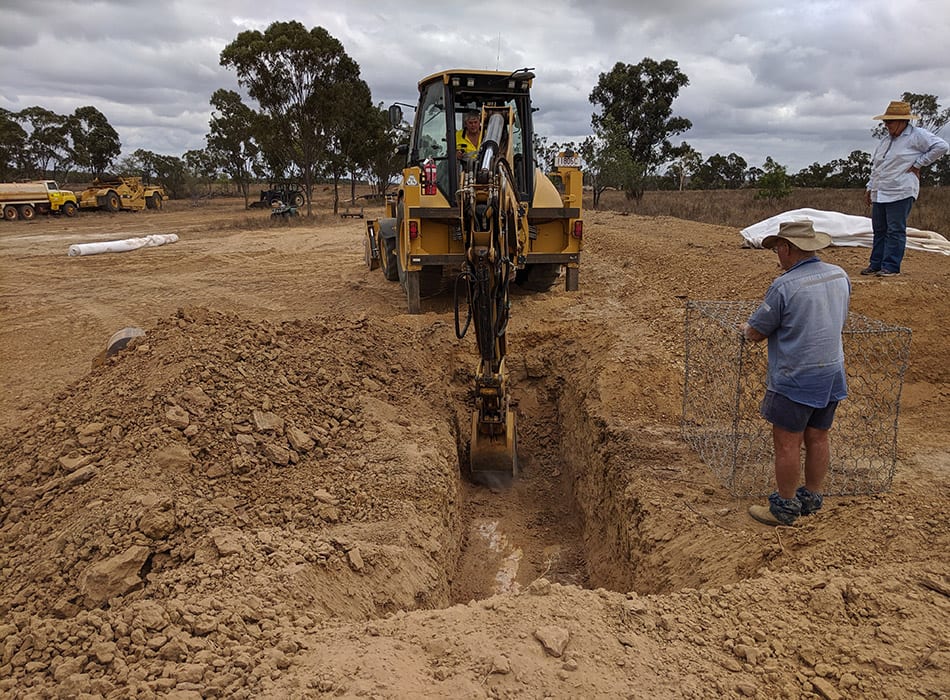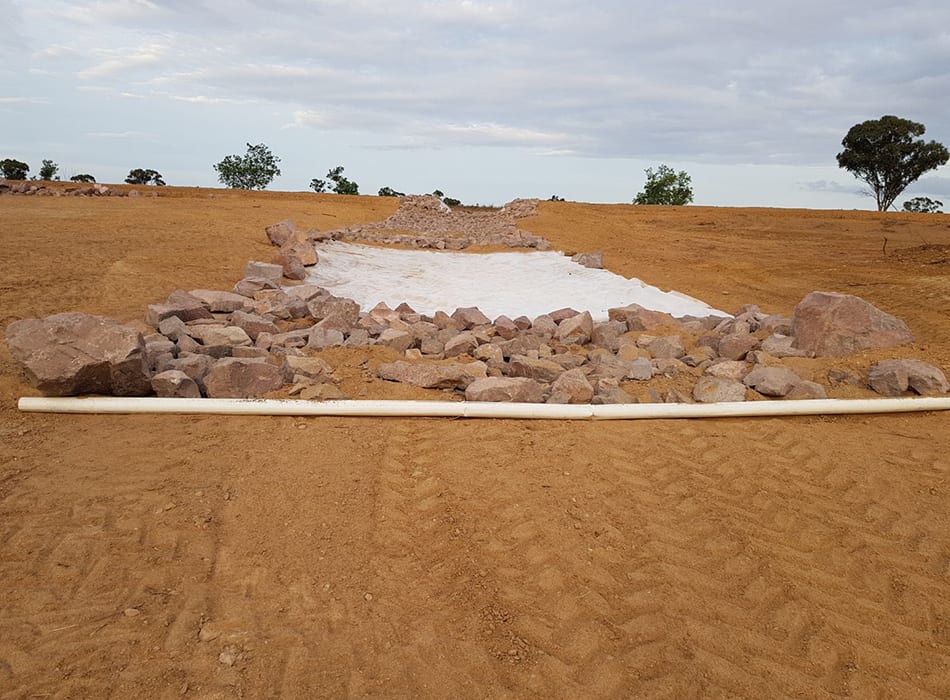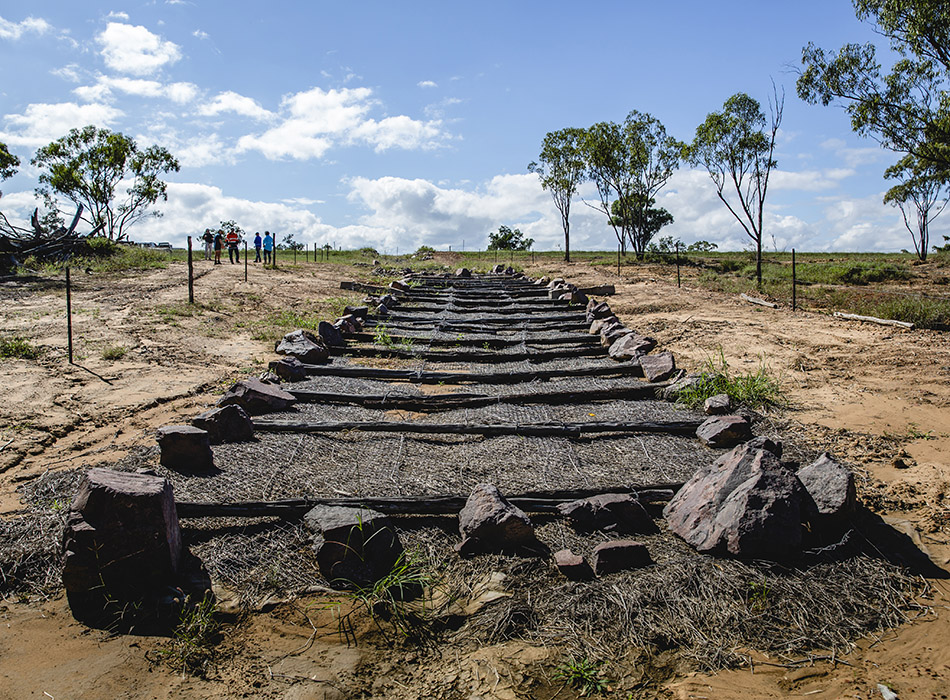
Isabel and Garry Sloan on the repaired bank at Hillview Station.
Two sites remediated at Hillview Station
Project description
Hillview sits on Three Mile Creek in the Pelican Creek sub-catchment of Bowen River and has been home to Garry and Isabel Sloan for 40 years.
The 242ha property covers a range of land types including narrow-leaf ironbark on deeper soils, box country on Sodosols, and some cleared rosewood scrub country. The Sodosols are fragile and highly prone to erosion problems.
In wet seasons, a hole in the dam wall resulted in surface runoff to become concentrated into a well-defined channel, pictured, that could eventually grow to become gullies. The hole was repaired, and the surrounding area was reshaped and seeded following remediation works.
Site 1 – work completed.
The following was carried out on Site 1:
- Upslope deep ripping (using the property owner’s machinery) to improve water infiltration and limit overland flow.
- The existing borrow pit was reshaped and deepened to take pressure off the wall.
- The existing diversion bank wall was built higher (from 0.9m to 2m) and extended at each end (from 112m to 182m long) with the excavated subsoil.
- The hole in the bank was repaired with suitable subsoil.
The remediation project involved two separate sites.
Site 1 (pictured above) had an existing diversion bank built higher and longer, and a hole in the bank was repaired. The surrounding area was reshaped and seeded.
Site 2 (pictured below) had two diversion banks constructed from each side of a gullied area to divert surface water runoff to a centre point above the gullies. A rock chute over geo-fabric was installed to carry the discharge from the diversion banks into the creekline area below.
Both sites were contour-ripped above the gullies and diversion banks to improve water infiltration and pasture growth, and to minimise erosion risk from future surface water flows.
The landholders chose to supervise the project directly and use their own machinery. They also used an experienced local earthworks provider Bernie Fordham, of Fordham Earthworks NQ.
- These photos show the construction of a rock chute on Hillview. It was installed to carry the discharge from two diversion banks that were built above the gully to divert surface water runoff.
The site cleared, and prepared for earthworks. The posts show contour levels, 7.1 per cent fall over 35m.
Site 2 – work completed.
Site 2 was a gullied area at the bottom of a slope where runoff had accumulated, and was 50m wide with a 0.5m deep head.
To address the erosion problem at this site two diversion banks were constructed to divert the surface water runoff from each side of the gullied area to a centre point above the gullies.
Construction of a rock chute (3m wide with 1m wide batters on each side) over geo-fabric was designed to carry the discharge from the two diversion banks into the severely eroded area below.
The catchment area above the site was contour ripped to reduce the volume of runoff contributing to the gullied area.
The property owner, contractor and a LDC field officer took contour readings of both Site 1 and 2 to verify lengths and locations of the diversion structures and the rock chute. The rock chute levels were then run through a computer model to ensure modelled flows would not exceed the chute design tolerances.
Local contractor Kevin Beauhamp of Beauchamp Excavating provided half a day of backhoe services to install the four gabion baskets.
Despite budget constraints, one tonne of gypsum was used on Site 2 and was spread by the landholder Garry, with his 90 hp Iseki tractor and a hired dingo to fill the bucket.
What was the problem?
Over-grazing around waterways had resulted in low ground cover generating excess runoff and causing soil erosion.
“On the fragile soils that are a feature of this part of the Bowen River catchment, once the topsoil layer has been breached, even in small areas, gully erosion develops rapidly and extensively, particularly at toe-slopes where runoff volumes are the greatest and fastest.” (Bob Shepherd).
Following an on-site inspection, DAF principal extension officer Bob Shepherd produced a technical report that outlined remediation options. This was done in consultation with the property owners and local contractor Bernie Fordham, of Fordham Earthworks NQ.
To offset costs the landholders decided to supervise the project, as well as providing some in-kind machinery, significant labour, and some materials.
What were the challenges?
- Ensuring works came under budget.
- Finding topsoil to reseed and cover the sites.
- Securing the section of geofabric in place where rock was in short supply.
- Finding topsoil to reseed and cover the sites.
- Securing the section of geofabric in place where rock was in short supply.
- Placing rock on the geofabric without damaging the fabric.
- Making sure to work early morning to avoid the heat.
- The physical nature of the work.
- Having all the materials ready when they were needed.
Looking from the bottom of the gully site up to the gully head and the two diversion banks that were constructed to diver surface water runoff.
The Sloans were unable to source enough rock to cover the full length of the geofabric. About one third of the area was covered with hay and disused wooden rail sleepers and fence posts. It was important for the landholders to recycle items.
Completed works. The site has also been fenced to remove grazing pressure to allow vegetation cover to establish on the remediated area.
Local contractor Bernie Fordham, of Fordham Earthworks NQ, pictured in front of the remediated gully. Bernie had input into the design of the remediation works carried out on Hillview in consultation with the landholders and DAF principal extension officer Bob Shepherd.














